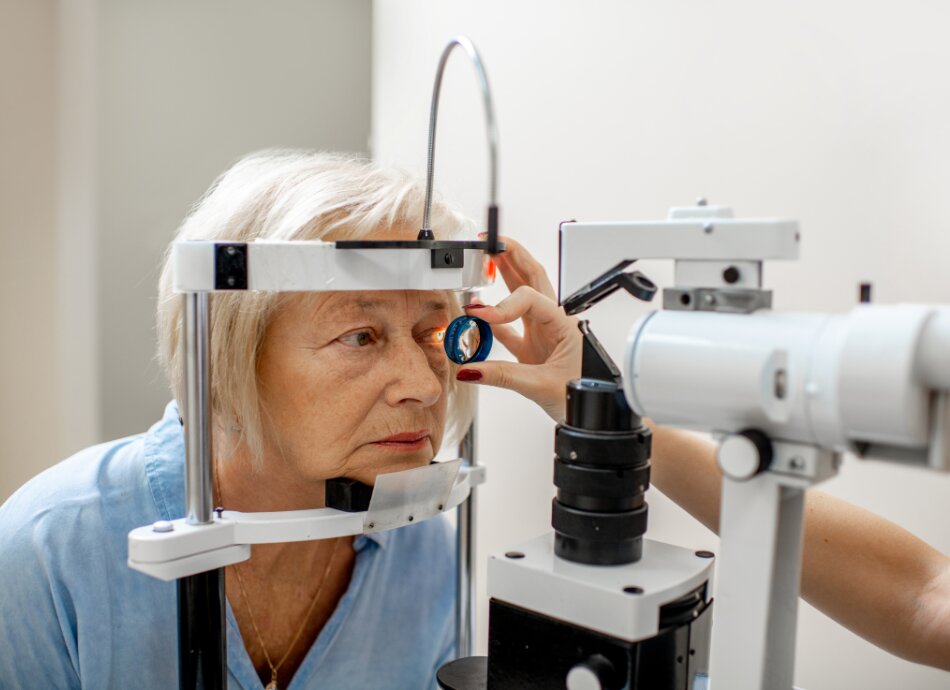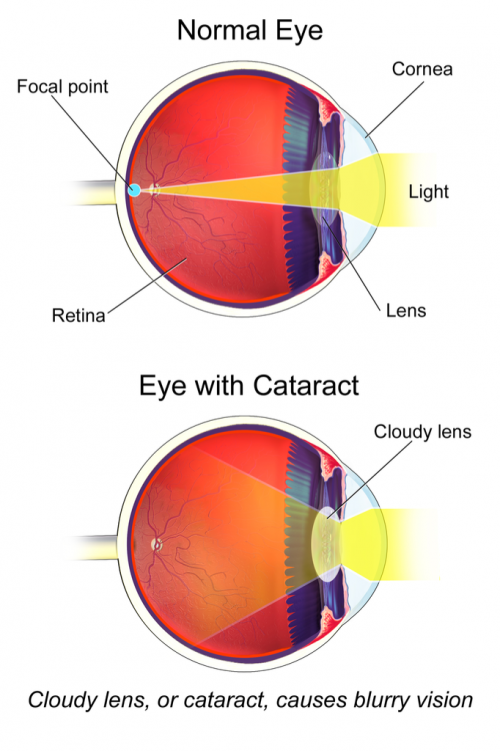Cataracts | Karu puata kore
Key points about cataracts
- A cataract (karu puata kore) is when the lens of your eye becomes hazy or milky.
- Cataracts are very common and often develop as you get older, so it's important to have regular eye examinations.
- The first symptoms include blurry vision (as if you're looking through frosted glass), double vision, shadowing of images, increased glare and colours appearing dull.
- Cataracts can be successfully removed through surgery, which is very safe, painless and generally has an excellent outcome.

A cataract is when there’s clouding (opaqueness) in the lens of your eye. The lens is normally clear, allowing light to enter through it so you can see a clear image of what you’re looking at.
The image below shows how cataracts affect your vision. The diagram at the top shows the light rays being focused on the retina in the normal eye. However, in an eye with a cataract, the light rays become scattered by the hazy lens and are no longer focused on the retina.

Image credit: Bruce Blaus via Wikimedia Commons(external link)
The cloudiness usually develops quite slowly, and gradually you’ll notice your vision becoming clouded, blurry or dim. One type (posterior subcapsular cataract) grows faster than others. Read more about the types below. Cataracts usually develop in both eyes but not always at the same speed.
Cataracts often develop as you get older. It’s unusual to have cataracts before the age of 40 years. However, some children are born with cataracts (congenital cataracts) or have a family tendency to develop cataracts earlier in life.
As you get older, the lens changes in the following ways:
- Your lens might get clumps in it: Your lens is made up of mostly water and protein. Normally, these proteins are arranged in a highly ordered manner to allow light to pass easily. However, with cataracts these proteins become clumped and irregular, obstructing the passage of light. This is perceived as blurry vision.
- Your lens might change colour: The colourless natural lens begins to turn yellow with exposure to UV light. This gradually affects your ability to perceive colours, which become less bright or different as the cataract develops.
Other factors that may increase your risk of getting cataracts include:
- eye injuries
- diabetes and other metabolic conditions
- smoking
- increased exposure to sunlight and ultraviolet light
- certain medications.
There are different types of cataracts.
- Nuclear cataracts affect the centre of the lens causing far off objects to appear blurry, and eventually making colours hard to tell apart.
- Cortical cataracts start as white spots or streaks at the outer edge of the lens. Over time the streaks spread to the centre leading to blurred vision and sensitivity to light.
- Posterior subcapsular cataracts affect the back of the lens in the path of light causing poor vision in bright light and halos around lights at night. These tend to grow faster than others.
- Congenital cataracts are the ones you’re born with.
It’s possible to get more than one type in the same eye.
Cataracts may begin as a mild haziness of your vision that's worse in bright light and with night driving. As it gets worse, your vision can become very cloudy in all situations. Changing your glasses may help in the early stages but you will eventually need to have surgery.
Common symptoms of cataract include:
- cloudy or blurry vision
- colours seeming faded
- glare
- light may appear too bright
- seeing halos around lights
- poor night vision
- a brownish tint to your vision
- double vision or multiple images in one eye.
Most cataracts are not visible to the naked eye, unless they’re severe. If you have severe cataracts, the centre of your eye (your pupil) will be grey or white.
Video: Cataracts animation
(NHS, UK, 2017)
If you’re concerned that you might have cataracts, see your eye care provider for an eye examination. This might be an optometrist or an ophthalmologist.
An optometrist is a health professional who has been trained to diagnose eye diseases, while an ophthalmologist is a specialist medical doctor who has been trained in diagnosing and managing eye conditions, including performing eye surgery.
Your eye care provider can see if you have cataracts by performing a thorough eye examination. This may include the following tests:
Measuring your vision
You will be asked to read letters from an eye chart. This measures how well you see at different distances.
An examination of the outside of your eye
A special microscope is used to examine your eyelids, the condition of the front of your eye and the lens. A special yellow fluorescent dye may be used to assess your eyes for dry eye. This dye will wash away in your tears and isn’t permanent.
An examination of the inside of your eye
In this test, drops are put in your eye to make the hole in the centre of your eye (called your pupil) wider. This is called dilating your pupil. A special magnifying lens is used to look inside your eye to see if you have a cataract and how bad it is. It's best to not drive for several hours after a dilated eye examination.
A tonometry test
In this test, an instrument is used to measure the pressure inside your eye. This tests for glaucoma.
Cataracts are treated with surgery (an operation). They can be treated at any stage. There’s no need to wait for the cataract to ‘ripen’ before it can be treated, although this is a common belief.
Cataract surgery is usually a short procedure, lasting about 45 minutes.
- Most people stay awake during cataract surgery but have a light sedative to relax them during the treatment.
- Often your eye can be numbed with anaesthetic jelly or by using a small plastic tube to put anaesthetic under the outer layers of the eye (a sub-Tenon block).
- It's typically a day procedure, and you don't need to stay in hospital overnight.
- Most people find this a very comfortable operation.
Treatment involves removing the cloudy natural lens inside your eye. Once the hazy cataract has been removed, a new clear plastic lens is inserted through a small cut (less than 2 mm) into your eye. The new lens can't be rejected by your body and can't go cloudy like your natural lens can.
If both eyes need cataract surgery, they will be operated on at different times, to prevent the risk of infection from one eye to another.
Improving eye focus
Special types of lens implants (intraocular lenses) are implanted at the time of cataract surgery to improve the focus of your eye and remove the cloudy vision. Careful measurements of your eye are performed before surgery to help to choose an appropriate implant that minimises near-sightedness, far-sightedness and/or astigmatism.
Although the newly implanted lens is very clear and transparent, it can't change focus in the same way as a young person’s natural lens does. This means reading glasses are often still needed afterwards. These may have to be prescription glasses, but you may only need non-prescription ones you can buy from a chemist or supermarket.
Special implants, called multi-focal and extended depth of focus intraocular lens, can also be used to reduce the need for reading glasses after the surgery.
Your ophthalmologist will discuss these options with you at the preoperative assessment.
What happens if my cataracts are not treated?
If you don’t have surgery your cataracts will continue to grow, and your vision will get worse. As long as the rest of your eye works normally, a cataract operation can restore your vision at any stage.
Apps reviewed by Healthify
You may find it useful to look at some vision difficulty apps.
Complications are extremely rare following cataract surgery. Cataract surgery is the most commonly performed operation in the Western world and is one of the safest operations done.
Potential risks include infection, inflammation, reduced vision, detachment of the layer at the back of the eye (retina) and blindness.
The intraocular lens is held by a bag (capsule) within your eye. This often becomes scarred following the surgery and may require a minor laser procedure (YAG capsulotomy) to be removed.
The following effects are temporary and disappear within a week or two:
- Your eye usually feels tender and light-sensitive for a few days afterwards
- Everything may look brighter coloured
- Sometimes your eye may look bloodshot or there may be small red marks on the white of your eye
- You may have small floating spots or a flickering effect in your vision.
Recovery period
It’s very unlikely that you’ll need to stay overnight in hospital after cataract surgery. However, you should rest at home for several hours with your eye closed. You may have a patch taped over the eye for a few hours after your surgery. You can often see well enough to drive in 1 or 2 days.
Plan to take a few days off work and try not to strain your eyes during this time. Don't go swimming for 1 week and avoid contact sports for at least a month after surgery. As cataract surgery is usually performed one eye at a time, you may find your eyes feeling unbalanced following the first surgery.
Follow post-operative instructions
There are several things you can do to lower your risk of any problems after your surgery.
- Rest for several hours afterwards, as directed by your surgeon.
- Take all the eye drops and medications exactly as prescribed.
- Call your surgeon immediately if you develop any increasing pain or sensitivity to bright light.
- Attend all your postoperative checks – it's usual to be seen the day after the operation and then again 3 to 4 weeks later.
- Don't wait until the next check-up if you're concerned – it's always best to contact the surgeon immediately.
- Get regular eye checks: As you get older, you should get your eyes checked regularly. Also get your eyes checked straight away if you notice any changes or you think your vision is not as clear as it used to be.
- Protect your eyes: Wear sunglasses to reduce glare and UV damage.
- Avoid smoking and drinking too much alcohol.
-
Eat well: Poor nutrition is a risk factor for developing cataracts.
Introduction to lens and cataracts(external link) Optho Book by Dr Tim Root, Ophthalmologist
Resources
Cataracts(external link) Association of Optometrists, NZ
Apps
References
- Cataracts(external link) Mayo Clinic, US, 2023
- Nizami AA, Gurnani B, Gulani AC. Cataract(external link) StatPearls, NIH, US, 2024
- Cataracts(external link) Auckland Regional HealthPathways, NZ, 2021
Learning resources
Dr Tim Root, an ophthalmologist with a background in graphic design and cartooning, has created video lectures and textbooks, all available online for free. These resources will help you understand eye anatomy, eye conditions and treatments.
Exam eye tricks for making examining eye easier(external link) Optho Book and Root Atlas
Cataract surgery video(external link) Optho Book and Root Atlas
Introduction to cataract surgery(external link) Optho Book and Root Atlas
Flashcards on lens and cataracts(external link) Optho Book and Root Atlas
Continuing professional development
Video: Common eye complaints webinar - David Garland
(Mobile Health, NZ, 2020)
Credits: Healthify editorial team. Healthify is brought to you by Health Navigator Charitable Trust.
Reviewed by: Dr Divya Perumal, Ophthalmologist, Auckland
Last reviewed:





